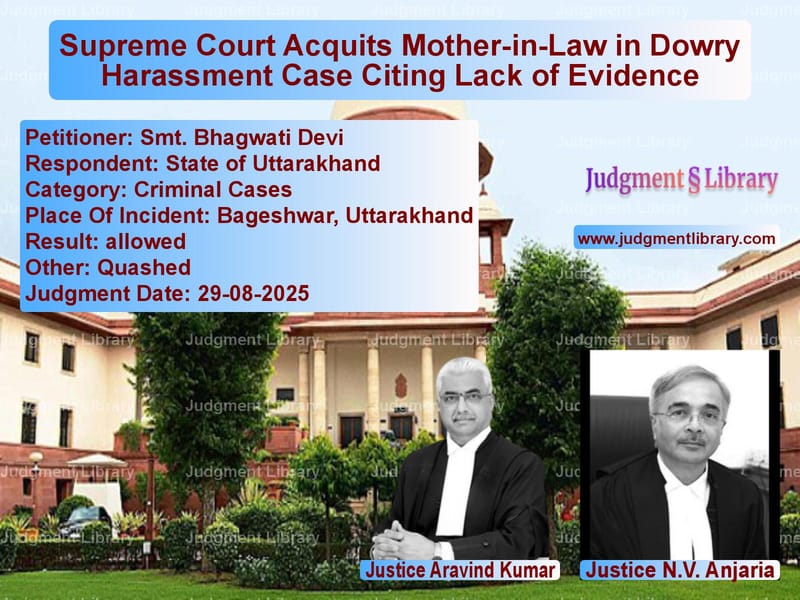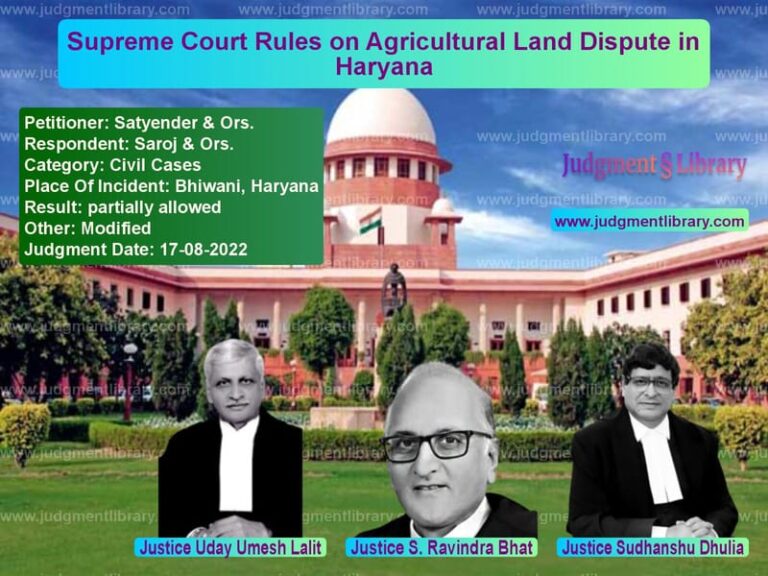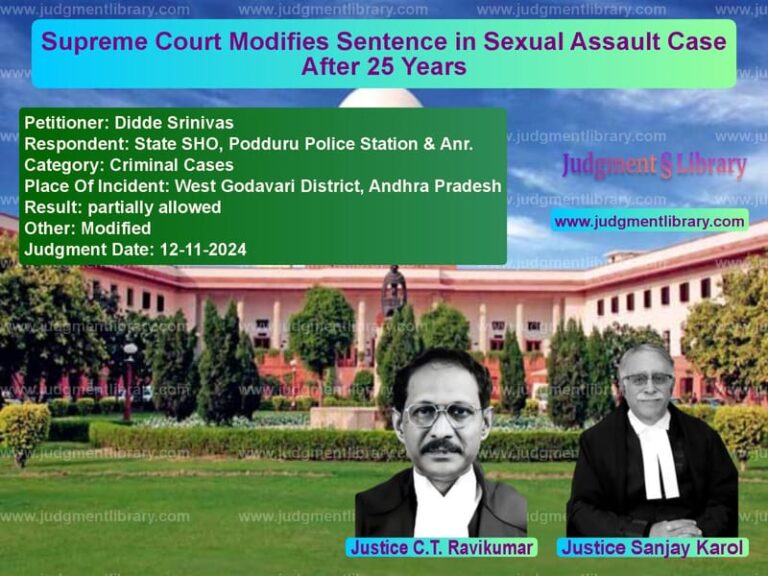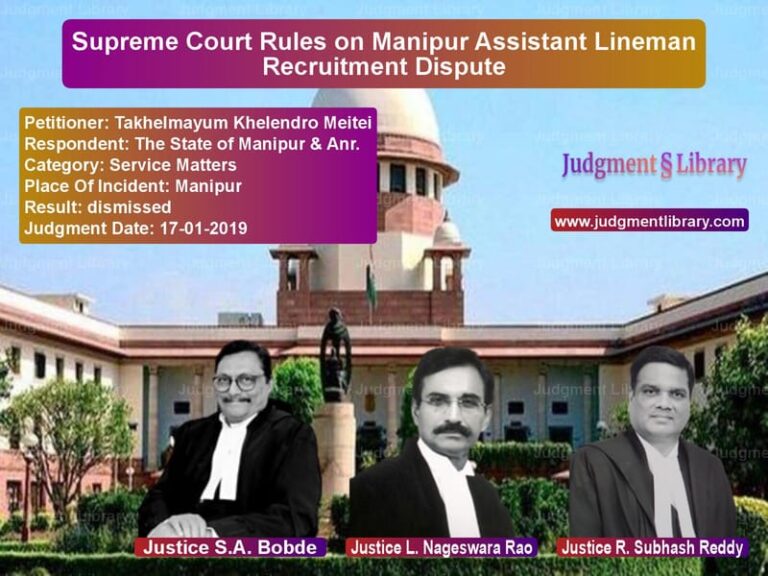Supreme Court Acquits Mother-in-Law in Dowry Harassment Case Citing Lack of Evidence
In a significant judgment that underscores the importance of concrete evidence in criminal cases, the Supreme Court of India has acquitted a mother-in-law who had been convicted for dowry harassment under Section 498-A of the Indian Penal Code. The case of Smt. Bhagwati Devi vs State of Uttarakhand represents a careful examination of what constitutes valid evidence in dowry harassment cases and serves as a reminder that convictions must be based on substantial proof rather than mere allegations.
The tragic case began on June 15, 2001, when Chandra Devi, the daughter-in-law of the appellant Bhagwati Devi, was found dead in her matrimonial home. The incident was reported by her father, Dharmanand Joshi (PW-1), who filed a complaint the next day alleging that his daughter had committed suicide by hanging herself. However, during his examination, he claimed to have seen wounds on his daughter’s body and noticed blood along with water oozing from her mouth. The complainant expressed doubts about the nature of his daughter’s death, suggesting she might have been killed. He also mentioned that his daughter was pregnant at the time of her death and had previously informed him that her mother-in-law made sarcastic comments about dowry.
The legal arguments presented before the Supreme Court highlighted the fundamental weaknesses in the prosecution’s case. Shri Anshumaan Purohit, learned counsel appearing for the Appellant, made several crucial submissions. He contended that “PW-1 complainant had not whispered a word in his complaint or in his evidence about any demand for dowry having been raised by the appellant and this vital aspect has been completely ignored by the courts below.” He further argued that “none of the independent witnesses examined by prosecution had deposed against the appellant to substantiate the offence of dowry demand and the witness examined on behalf of the appellant, namely neighbour Smt. Janki Devi (DW-1) had stated in unequivocal terms of no demand for dowry having been made by the appellant at any point of time.”
The appellant’s counsel elaborated that “conviction is based solely on uncorroborated statement of interested witnesses with no independent or medical evidence tendered to prove cruelty or dowry demand.” He further contended that “concurrent findings conveniently overlooked the absence of any specific dowry demand or by what act the appellant’s conviction could be justifiable under Section 498-A of IPC.”
On the opposing side, Smt. Saakshi Singh Rawat, learned counsel appearing for the Respondent, vehemently defended the lower courts’ decisions. She argued that “courts below have rightly arrived at a conclusion with regard to demand of dowry and the statement made by DW-1 examined on behalf of the accused was rightly not accepted or believed since such demand for dowry would be within the four corners of the matrimonial home and as such the courts below have rightly convicted the appellant for the offence under Section 498-A of IPC.”
The Supreme Court, in its detailed analysis, began by examining the legal framework of Section 498-A. The Court noted that “a perusal of Section 498-A would clearly indicate that whoever, being the husband or the relative of the husband of a woman, subjects her to cruelty would be liable to be punished with imprisonment for a term which may extend to three years and also liable to fine.” The Court further explained that “under the caption of explanation ‘Cruelty’ has been defined to mean and include any wilful conduct which is of such a nature as is likely to drive the woman to commit suicide or to cause grave injury or danger to life, limb or health whether mental or physical of the said woman or harassment of the woman or where the harassment is with a view to coercing her or any person related to her to meet any unlawful demand for any property or valuable security or is on account of failure by her or any person related to her to meet such demand.”
The Court referenced its earlier decision in Manju Ram Kalita vs. State of Assam, which had held that “‘Cruelty’ for the purpose of Section 498-A IPC is to be established in the context of Section 498-A IPC as it may be different from other statutory provisions. It is to be determined/inferred by considering the conduct of the man, weighing the gravity or seriousness of his acts and to find out as to whether it is likely to drive the woman to commit suicide, etc. It is to be established that the woman has been subjected to cruelty continuously/persistently or at least in close proximity of time of lodging the complaint. Petty quarrels cannot be termed as ‘cruelty’ to attract the provisions of Section 498-A IPC. Causing mental torture to the extent that it becomes unbearable may be termed as cruelty.”
Applying these legal principles to the facts of the case, the Supreme Court conducted a meticulous examination of the evidence. The Court observed that “the perusal of the complaint would indicate that the complainant had reached his daughter’s matrimonial home on 16.06.2001 at 4 A.M. and he came to know that his daughter had expired in the afternoon on 15.06.2001 and was informed that she had committed suicide by hanging. It is further stated that the deceased used to tell them during her visit to the paternal home that her mother-in-law used to comment on her sarcastically for dowry. There is not even a word with regard to any dowry demand having been raised by the appellant.”
The Court particularly scrutinized the evidence of PW-3, the mother of the deceased, which the trial court had heavily relied upon for conviction. The Court noted that “in the cross-examination she admits that her daughter had come with her younger brother-in-law and had not made any complaint about the members of the matrimonial home. She also admits that during Shiv Ratri her daughter had come alongwith son-in-law and she did not make any complaint. She further admits that when PW-1 went to drop her to her matrimonial home she did not make any complaint to her father about any demand for dowry being made. She further admits that the alleged demands made by father-in-law, mother-in-law and younger brother-in-law was for the first time disclosed in the court when she tendered her examination-in-chief.”
The Court further highlighted that “she also admits that the married life of her daughter was happy and cordial and at the time of marriage there was no demand for dowry. She infact admits at the time of marriage her son-in-law had told that he has no demand of dowry.” Based on this comprehensive analysis, the Court concluded that “a holistic look at the deposition of PW-3 that is the mother of the deceased would not inspire any confidence to any person of common prudence to arrive at a conclusion that on account of either harassment for dowry or on account of demand for dowry made by the appellant she had been perforced to commit suicide.”
The Supreme Court also gave due consideration to the defense witness, Smt. Janki Devi (DW-1), who had testified that the appellant had never made any demand for dowry. The Court noted that “she being neither the relative of the appellant nor belonging to the same community to which the appellant belongs would indicate that there was no interest in her to depose against the factual matrix or in favour of the appellant.” The Court criticized the lower courts for brushing aside this evidence “on the premise that she could not have deposed any fact with regard to the demand of dowry as it happens within the four walls is an erroneous finding particularly in such matters the word spreads faster than the wind about a daughter-in-law being harassed for the dowry by the parents in law.”
In its final analysis, the Supreme Court arrived at “the irresistible conclusion that the deceased had not committed suicide on account of either demand for dowry being made or cruelty being inflicted on her.” The Court emphasized that “the conviction of the appellant for the offence punishable under Section 498-A and the sentence imposed on her cannot be sustained.”
This judgment serves as an important precedent in balancing the need to protect women from dowry harassment while ensuring that criminal convictions are based on solid evidence rather than mere allegations. The Supreme Court’s careful scrutiny of witness testimonies and its insistence on corroborative evidence demonstrates the judiciary’s commitment to ensuring that justice is delivered based on facts and law, not emotions or presumptions.
The acquittal of Bhagwati Devi after years of legal battle highlights the importance of thorough judicial scrutiny in criminal cases, particularly those involving serious charges that carry significant social stigma and legal consequences. The judgment reinforces the fundamental legal principle that in criminal cases, the burden of proof lies squarely on the prosecution, and convictions cannot be sustained on weak, uncorroborated, or contradictory evidence.
Petitioner Name: Smt. Bhagwati Devi.Respondent Name: State of Uttarakhand.Judgment By: Justice Aravind Kumar, Justice N.V. Anjaria.Place Of Incident: Bageshwar, Uttarakhand.Judgment Date: 29-08-2025.Result: allowed.
Don’t miss out on the full details! Download the complete judgment in PDF format below and gain valuable insights instantly!
Download Judgment: smt.-bhagwati-devi-vs-state-of-uttarakhand-supreme-court-of-india-judgment-dated-29-08-2025.pdf
Directly Download Judgment: Directly download this Judgment
See all petitions in Dowry Cases
See all petitions in Domestic Violence
See all petitions in Bail and Anticipatory Bail
See all petitions in Fraud and Forgery
See all petitions in Suicide Cases
See all petitions in Judgment by Aravind Kumar
See all petitions in Judgment by N.V. Anjaria
See all petitions in allowed
See all petitions in Quashed
See all petitions in supreme court of India judgments August 2025
See all petitions in 2025 judgments
See all posts in Criminal Cases Category
See all allowed petitions in Criminal Cases Category
See all Dismissed petitions in Criminal Cases Category
See all partially allowed petitions in Criminal Cases Category







